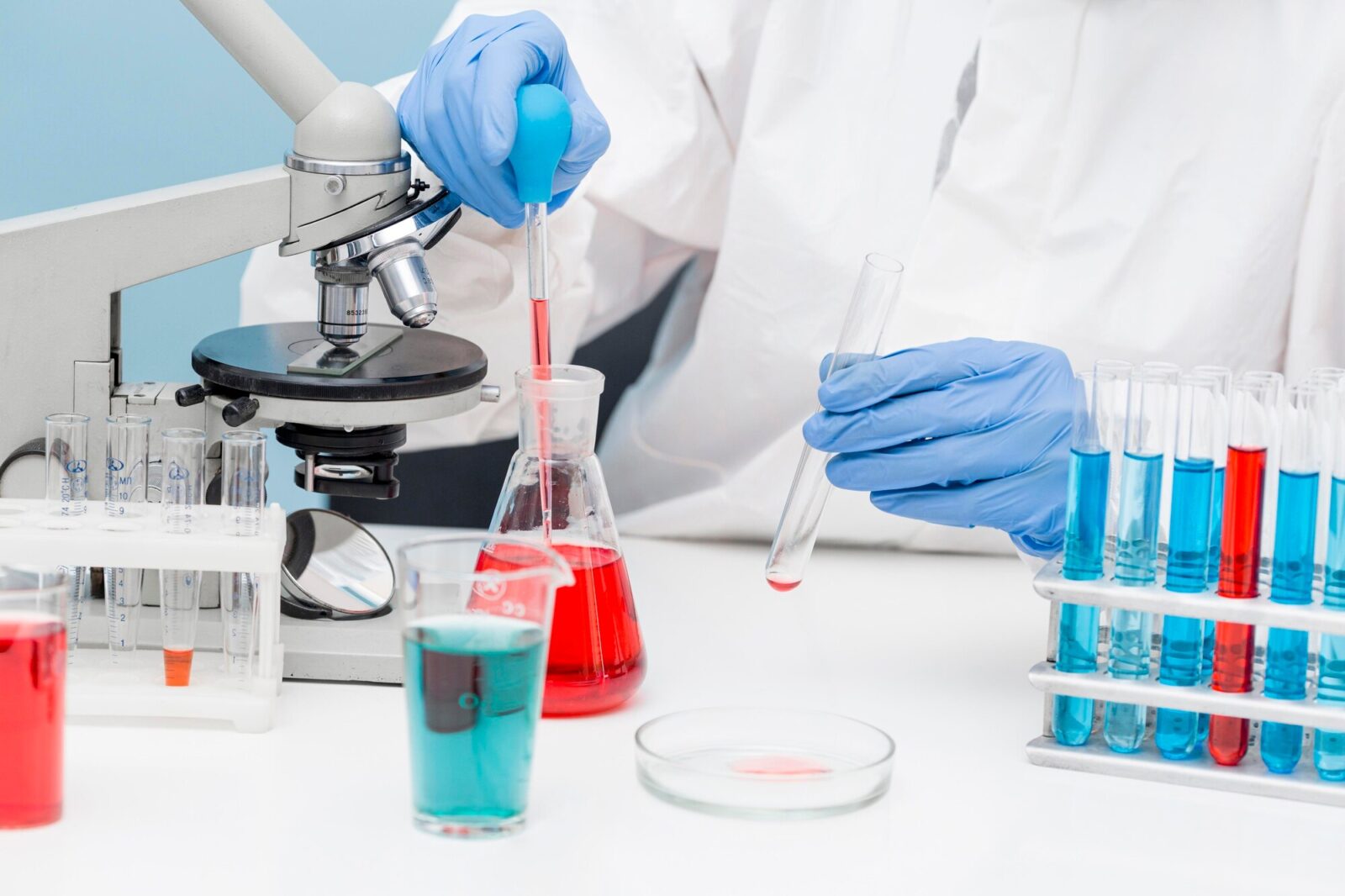
Arc Flash Gloves: Selecting the Right Protection
Choosing the right Arc Flash Gloves is key to ensuring your safety in high-risk environments like electrical maintenance or construction....

Get 20€ off on your first order!
Are you looking for the ideal chemical resistant gloves to enhance safety and efficiency in industries like chemical manufacturing, agriculture, or industrial maintenance? Choosing the right gloves can ensure optimal protection and support for your tasks. In this guide, we’ll help you evaluate chemical protection gloves, compare materials, make confident purchase decisions and ultimately where to find most of chemical resistant gloves in Europe
Choosing the best chemical protection gloves can be boiled down into few key factors:
Selecting the right glove material is critical. Here’s a comparison of the most commonly used materials for chemical resistant gloves:
| Material | Key Features | Typical Use Cases |
| Nitrile | Excellent chemical resistance, durable, puncture-resistant, and latex-free. | Handling solvents, pesticides, and cleaning agents. |
| Neoprene | Good resistance to acids, caustics, and oils; flexible and comfortable. | Industrial cleaning and chemical handling. |
| Vinyl | Cost-effective and flexible, but lower resistance to strong chemicals. | Light-duty cleaning tasks and low-hazard chemicals. |
| Latex | Offers flexibility and comfort; limited resistance to strong chemicals. | General-purpose tasks with low-risk chemicals. |
| Butyl Rubber | Good for ketones and esters. Poor for gasoline and hydrocarbons. | Extended contact use. |
| Norfoil | Good for most hazardous chemicals. Poor fit; dexterity can be regained by using a heavier Nitrile glove over it. | Extended contact use. |
| Viton | Good for chlorinated and aromatic solvents, resistant to cuts and abrasions, but poor for ketones and expensive. | Extended contact use. |
| Polyvinyl Chloride (PVC) | Good for acids, bases, oils, fats, peroxides, and amines. Poor for organic solvents. | Specific use. |
| Polyvinyl Alcohol (PVA) | Good for aromatic and chlorinated solvents, poor for water-based solutions. | Specific use. |
| Stainless Steel/Kevlar/Leather | Cut-resistant gloves; sleeves available for wrist and forearm protection. Use appropriate disposable gloves for contamination protection. | Specific use. |
| Cryogenic Resistant Material/Leather | Designed for cryogenic materials to prevent frostbite. Never dip gloves in liquid nitrogen. | Specific use. |
For a deeper understanding of glove materials, check our guide to glove materials for chemical protection.
The correct fit is essential for chemical safety gloves to provide optimal protection and comfort. When it comes to chemical resistant gloves made of nitrile, it’s important to note that they tend to fit snugly and offer less stretch compared to latex gloves. This snug fit provides excellent dexterity but may feel tighter for prolonged use, so sizing up slightly can improve comfort for extended wear.
Here is a European glove sizing chart to help you find the perfect fit:
| Hand Circumference (cm) | Glove Size |
| 18-20 | XS |
| 20-22 | S |
| 22-24 | M |
| 24-26 | L |
| 26-28 | XL |
| 28-30 | XXL |
To measure your hand size accurately, use a measuring tape around the widest part of your palm, excluding the thumb. If you need greater precision for tasks requiring fine motor skills, also consider measuring finger length and hand width to ensure the best fit.

Chemical resistant gloves are essential across a variety of industries, including:
For industrial workers, durability and chemical resistance are non-negotiable features. Explore high-quality chemical resistant gloves on platforms such as Droppe.
When purchasing chemical protection gloves, sourcing from trusted suppliers ensures quality and compliance with safety standards. Here are some of Europe’s most popular chemical resistant glove suppliers:
If your work involves tasks beyond chemical handling, you may benefit from understanding other glove categories. For guidance tailored to specific applications, explore these resources:
These additional guides can help you identify the right gloves for unique safety and performance requirements in various fields.
Choosing chemical resistant gloves that suit the specific chemical type and exposure duration is essential for maintaining effective safety measures. To help you make an informed decision, here are some helpful tips to ensure optimal glove selection and avoid common oversights:
We hope this guide has been helpful in navigating the essential factors for choosing the best chemical resistant gloves, from material compatibility to industry standards. Whether you’re protecting yourself in chemical manufacturing or ensuring safety during agricultural tasks, we’re here to support your needs.
Explore the full range of Chemical Resistant Gloves on Droppe, where trusted brands like Ansell, Showa, and Unigloves are just a click away.
Have questions or need advice on finding the perfect gloves? Don’t hesitate to reach out—we’re always here to help ensure your safety and confidence in every purchase.
– The Droppe Team
Look for certifications such as:
– EN ISO 374: Ensures gloves meet European chemical protection standards.
– CE marking: Indicates compliance with European health and safety requirements.
Check the product packaging or consult the manufacturer’s specifications to verify these certifications.
Yes, nitrile and vinyl gloves are excellent alternatives for individuals with latex allergies. Nitrile gloves, in particular, offer durability and chemical resistance without the risk of latex-related reactions.
To determine compatibility, consult the glove manufacturer’s chemical resistance chart, which outlines how various materials perform against specific chemicals. Look for ratings on permeation (how quickly the chemical passes through) and degradation (how the glove material breaks down when exposed to the chemical).
Permeation: The rate at which chemicals pass through the glove material at a molecular level.
Degradation: Physical damage to the glove material, such as swelling, shrinking, or cracking.
Penetration: When chemicals seep through imperfections, seams, or pores in the glove.
Understanding these distinctions is crucial for selecting the right level of protection.
Yes, certain gloves are designed to provide both chemical and heat resistance. Materials like neoprene or specialty blends are often used for dual protection. Always check the glove’s temperature resistance specifications in addition to chemical resistance levels.
The replacement frequency depends on:
Chemical exposure duration: Extended contact may degrade gloves quickly.
Glove material: Some materials are more durable than others.
Task intensity: Heavy-duty tasks may lead to quicker wear and tear.
Always inspect gloves for signs of damage, discoloration, or changes in texture before use.
Reusability depends on the glove material and the chemicals handled. Gloves made of nitrile, neoprene, or other durable materials can be reused if properly cleaned and inspected. However, disposable gloves, such as vinyl and lightweight nitrile, are intended for single-use only.
Rinse gloves thoroughly with clean water after use.
Wash them with mild soap if chemicals are water-soluble.
Dry completely before storing in a cool, dry place.
Avoid exposing gloves to direct sunlight or heat, as this may degrade their material.
Yes, multi-purpose gloves made from materials like nitrile or neoprene often provide protection against a range of chemicals, including acids, oils, and solvents. However, always check the chemical compatibility charts to confirm their suitability for your specific chemical combinations.
Signs of glove failure include:
Visible tears, holes, or cracks.
Discoloration or swelling of the material.
A change in glove texture, such as becoming soft, sticky, or brittle.
Any chemical smell or residue on your skin after use.
Thank you! You've signed up for our newsletter.



















Choosing the right Arc Flash Gloves is key to ensuring your safety in high-risk environments like electrical maintenance or construction....

Choosing the right Rubber Insulating Gloves is essential for safety in electrical work, but with so many options, it can...

Are you looking for the right electrical insulating gloves to ensure your safety? This guide will help you understand the...

Choosing the right Arc Flash Gloves is key to ensuring your safety in high-risk environments like electrical maintenance or construction....

Choosing the right Rubber Insulating Gloves is essential for safety in electrical work, but with so many options, it can...

Are you looking for the right electrical insulating gloves to ensure your safety? This guide will help you understand the...
Get 20€ off on your first order!
Save 30% by buying directly from brands, and get an extra 10€ off orders over €100
Save 30% by buying directly form brands, and get an extra 10€ off orders over €100